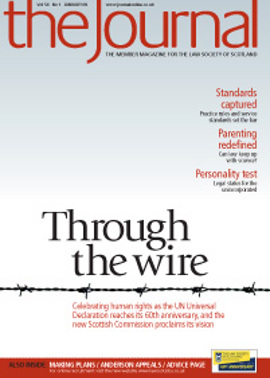Parenthood reborn

It is a truth that has bedevilled the male psyche since the dawn of civilization that women always know who their children are, but men never do. The law has had to respond to this by deeming and presuming and defining “father” in much more complex ways than it defines that far simpler idea, “mother”.
These complexities have increased exponentially through technological advances, and changes in our understandings of family life, in the past 30 or 40 years. The Human Fertilisation and Embryology Act 1990 was a remarkably early attempt to regulate processes and families but, through no fault of its own, it has not aged well. The Human Fertilisation and Embryology Act 2008 substantially amends the earlier Act and aims to bring the law into line with the astounding changes in both scientific knowledge and how we construct the concepts of “family” and “parent”. Only the latter issue will be considered here.
The basic need: good parenting
The 1990 Act was passed at the height of the Conservative Government’s infatuation with “family values” as the basis of all policy; it was barely two years previously that that malign provision, “section 28” (of the Local Government Act 1988) – “Thou shalt not promote homosexuality as a pretended family relationship” – had been passed. While lesbian couples and single women were not explicitly barred from accessing infertility services, licensed clinics were nevertheless required by s 13(5) of the 1990 Act to “take account” of the welfare of any child likely to be born as a result of the treatment, “including the need of that child for a father”.
The 2008 Act amends s 13(5) so that the factor to be considered is “the need of that child for supportive parenting”. Sensibly, we no longer assume that disadvantage flows from single parenthood, or lesbian mothers, nor that maleness in a parent guarantees children’s welfare.
Lesbian couples as mothers
The 2008 Act cannot quite bring itself to allow a child two mothers, but, following the lead of the recent adoption legislation and the Civil Partnership Act 2004, it provides for a child having two parents who may or may not be of the same sex: children will have a “mother” and in addition either a “father” or another “parent”.
There is no change to the 1990 rule that if a married woman gives birth after infertility treatment at which sperm from someone other than her husband is used, her husband will nevertheless be treated for all purposes of law as the child’s father, unless it is shown that he did not consent to that treatment (2008 Act, s 35, replacing 1990 Act, s 28(1)). But this rule is extended to civil partners. So if a civil partner gives birth after infertility treatment, her partner will be treated for all purposes of law as “a parent of the child”, unless it is shown that she did not consent to that treatment (2008 Act, s 42).
The 1990 Act, s 28(2), deemed fatherhood on the unmarried (necessarily male) partner of a woman who becomes pregnant through infertility treatment. The 2008 Act repeats this (ss 36 and 37) and applies an equivalent rule to same-sex couples (ss 43 and 44). So the male partner of the woman who bears a child becomes “the father” and the female partner becomes “a parent”.
Additionally, the very nature of the rule is changed. Under the 1990 Act, the (unmarried) male partner of the mother would be treated as the father whenever it was shown that the treatment had been provided to him and the woman “together”. The concept of “treatment together” led to an inordinate amount of litigation, for many couples separated during the course of frequently long-term treatment. So this concept has been replaced by the issue of consent. But notice: while a husband or civil partner becomes father or parent by not withholding consent to the treatment, the unmarried or unempartnered partner will become father or parent by giving written consent to being treated as parent.
Section 3 of the Children (Scotland) Act 1995 is consequentially amended to ensure that a person who is a parent by virtue of s 42 of the 2008 Act (i.e. the civil partner of the mother) shall have automatic parental responsibilities and parental rights in relation to the child. And the unempartnered female partner of a mother will have automatic parental responsibilities and parental rights if she is deemed parent by s 43 and is registered as such – putting her in the same position as the unmarried father.
Adoption
The 2008 Act aims to provide a parenthood regime after infertility treatment that is consistent with the adoption regime, but this is not completely achieved. Under both the English Adoption and Children Act 2002 and the Adoption and Children (Scotland) Act 2007, the law permits a child to have two parents of the same sex, either registered as civil partners or not. But to become joint parents under the 2008 Act, unmarried/unempartnered couples must satisfy a requirement that does not appear in the adoption legislation: ss 37(1)(e) and 44(1)(e) provide that the couple must not be within the “prohibited degrees of relationship” (defined in s 58(2)) in relation to each other.
Now, there is no such requirement in any other legislation governing cohabiting couples. Doubtless it will normally be implied from the conjugality inherent in cohabitation: it is difficult to imagine the court holding a couple who are, say, aunt and nephew, to be “living together as if husband and wife in an enduring family relationship” (Adoption and Children (Scotland) Act 2007, s 29(3)). But the English Act uses a different definition of unmarried/unempartnered couple: “two people living as partners in an enduring family relationship” (Adoption and Children Act 2002,
s 144(4)). This could, conceivably, cover the non-conjugal family relationship of aunt and nephew, or niece. For there is more to “family” than conjugality.
Financial provision on dissolution
Section 9(1)(c) of the Family Law (Scotland) Act 1985 is also amended, though confusingly so. Presently, this provides as one of the principles for financial provision on dissolution of a civil partnership that there should be a fair sharing, after dissolution, of any economic burden of caring for any child who has been accepted by both civil partners as a child of the family. The 2008 Act extends this to the economic burden of caring for any child of whom the civil partners are the parents “by virtue of sections 33 and 42” of the 2008 Act.
Had this amendment referred to s 42 alone it would have been understandable: the person deemed “parent” by that section would be obliged to share in the ongoing costs of caring for the child whether or not she had accepted the child as a child of the family. But the amendment applies only to children born to a couple who are parent by virtue of s 42 and mother by virtue of s 33. So it is limited to the situation where one woman conceives using an embryo not her own.
Not covered is the far more common scenario of a civilly empartnered woman conceiving using her own embryo – in other words, through simple artificial insemination. Now, while someone who is not a parent might properly be allowed to escape ongoing costs of caring for a child they have never accepted as their own, it is very different with a woman who is for all purposes of the law a parent – the question of acceptance should not arise and she should no more be allowed to escape these costs than a father who deserts his pregnant wife. But limiting the amendment to partners who are parents through both sections 33 and 42, allows a parent to escape liability if she shows she has not accepted the child as a child of the family. The easy solution would be to hold that the very giving of consent necessary to become parent under s 42 is in itself the act of acceptance. But if that is correct, then the need for this amendment is lost.
And it is to be noted that no amendment is made to the Family Law (Scotland) Act 2006, which governs claims for financial settlement at the separation of cohabitants. Section 28(2)(b) makes competent a financial claim to share upbringing costs when both cohabitants are the parents of the child, whether or not there is “acceptance” of that child. It serves no policy to rely on acceptance for civil partners when both are also parents, and indeed is contrary to the policy behind the 2006 Act that the liabilities of cohabitation should be looser than the liabilities of marriage/civil partnership. The amendment of s 9(1)(c) of the 1985 Act thus contains error.
There is clearly much to be commended in these new provisions, but once again it is shown that defining who a child’s parents are is a complex and artificial process. The law is unlikely to remain static in this area.
In this issue
- Public law in Scotland
- Harmony in conflict management
- Tapping Reeve and his legacy
- Busy times at 60
- Living wills - why?
- Forward by the rights
- A cornerstone of rights
- Welcome for rejections takeup
- Sins of omission
- A time to buy?
- Parenthood reborn
- Persons unknown
- Front of the class
- Setting the standards
- Client service: the standards
- Judicial appointments: how you can take part
- ABS - the next phase
- Third parties and premature complaints
- Planning to perform
- Manual for the mind
- Computing on tap - or money down the drain?
- When resolution is not enough
- Ask Ash
- Making up lost time?
- Don't get caught short by transfer traps
- Collaboration: a new dimension
- Packed and ready
- Regulator on a roll
- Scottish Solicitors' Discipline Tribunal
- Website review
- Book reviews
- Medicines: the wrong cure
- Fraud alert! (and a cautionary tale)






